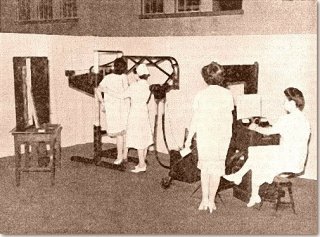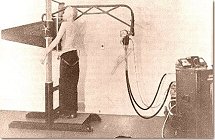Basically, the fluorograph is the simple combination of a high speed camera which photographs the image on a fluorscopic screen. In practice, the fluorograph is anything but a simple apparatus and the results achieved from its use were revolutionary. In one Canadian survey, more than one thousand persons were examined in seven hours and the films made ready for interpretation the same day. This is a remarkable record and one which could not have been made by the same staff using old-style methods of examination; equally important is the fact that the film cost per person is about one-fiftieth the cost of a standard 14"X17" x-ray film. Speed and economy, these are the factors which had been the stumbling blocks in any previous attempts at mass survey work, and with them mastered, the work of prevention was able to surge forward at an unequalled pace.

|
|
A patient is x-rayed using a photofluorograph machine to look for active tuberculosis. This was one of the first fluorgraph outfits, assembled by Robert S. Connell, a young worker at the Fort San who went on to market a similar machine for Picker X-ray of Vancouver. |
|



